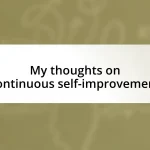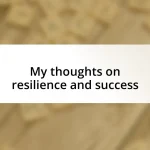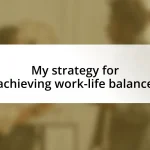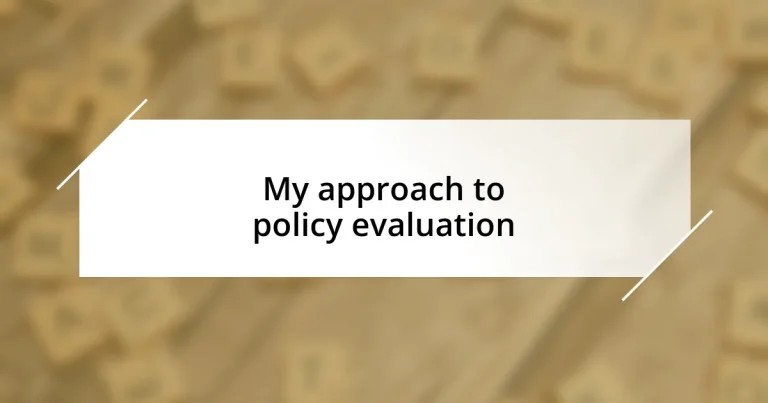Key takeaways:
- Understanding the policy evaluation process requires a balance of quantitative data and qualitative insights for a comprehensive assessment.
- Formulating clear and adaptable evaluation questions, with stakeholder engagement, enhances the relevance and accuracy of findings.
- Choosing the right mix of evaluation methods, such as surveys and focus groups, helps capture both statistical changes and personal experiences.
- Effective communication of evaluation results involves storytelling and tailoring the message to the audience to inspire actionable change.
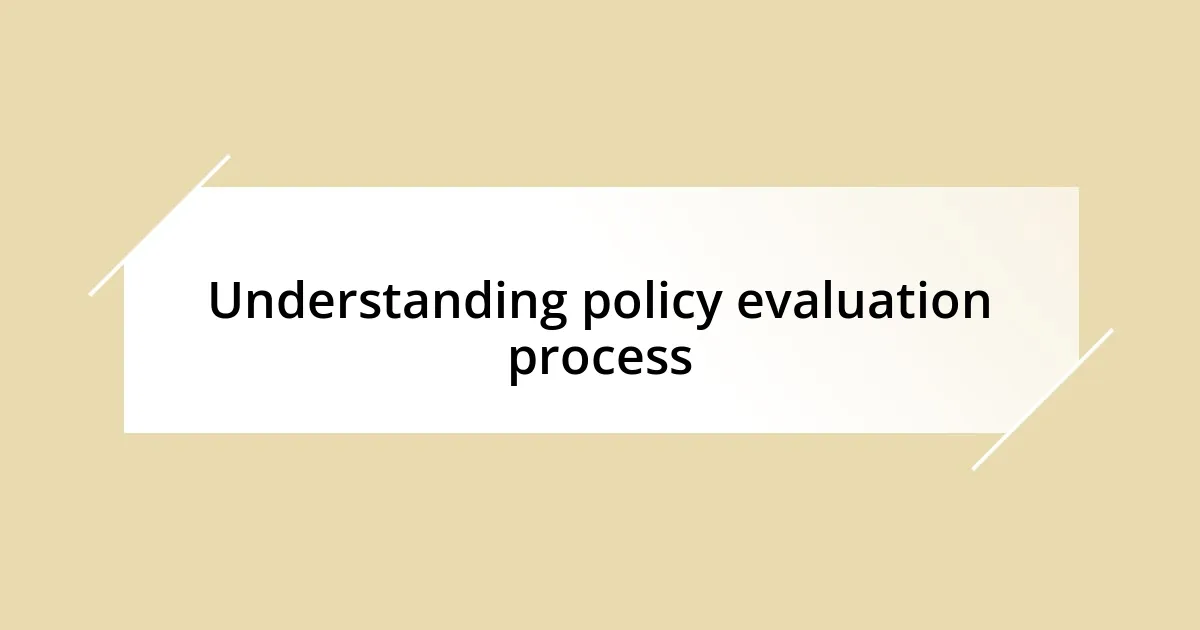
Understanding policy evaluation process
Understanding the policy evaluation process is crucial for determining whether a policy is achieving its intended outcomes. I remember a time when I was involved in a project that assessed the effectiveness of a new community health initiative. Watching the data unfold, I realized how important it is to not just look at numbers but to listen to personal stories that paint a fuller picture of the impact on people’s lives.
As I delved deeper into evaluation techniques, I found that there are multiple approaches, such as formative and summative evaluations. Have you ever considered how each method serves a different purpose? For instance, formative evaluation focuses on the development phase of a policy, allowing for tweaks and adjustments before implementation. In contrast, summative evaluation measures the final outcomes, helping us learn what worked and what didn’t.
The evaluation process often feels daunting. I often ask myself, what metrics should we really focus on? In my experience, it’s essential to balance quantitative data with qualitative insights to truly assess a policy’s effectiveness. This blend not only provides a more holistic view but also sparks conversations around what needs to change or improve—a fundamental part of learning and growth in policymaking.
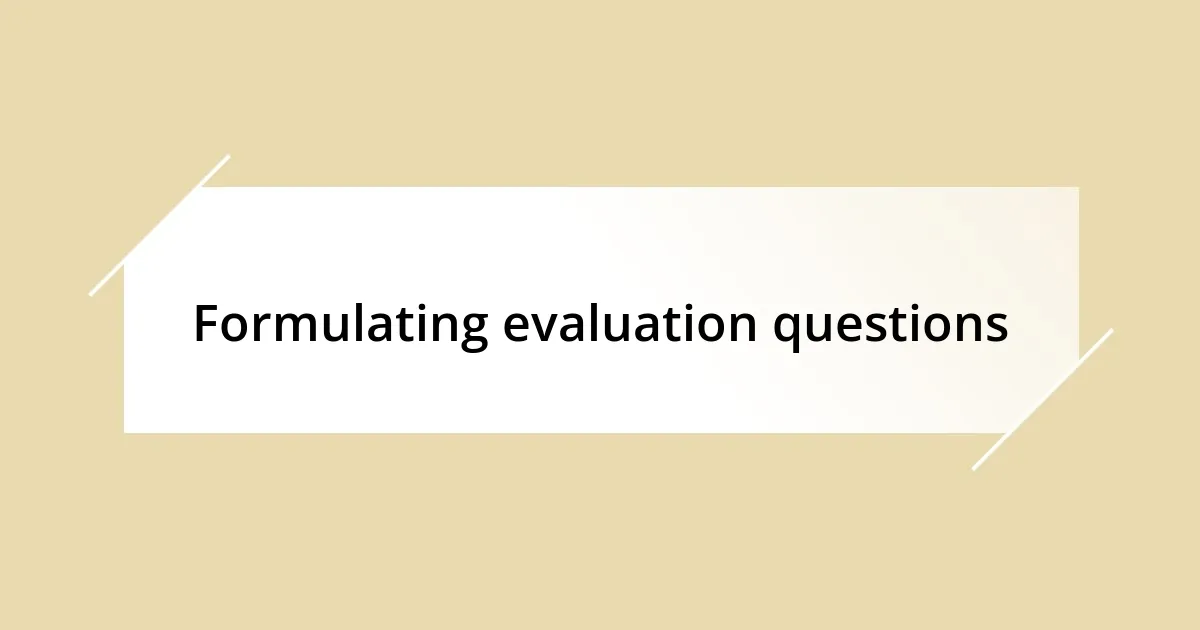
Formulating evaluation questions
When formulating evaluation questions, clarity is your best friend. I’ve learned that it’s essential to ask specific questions that define what success looks like for the policy at hand. For example, instead of asking broadly, “Is the policy effective?” I recommend narrowing it down to, “How has the policy improved community health outcomes over the last year?” This approach not only helps in gathering targeted data but also aligns stakeholders on the main objectives.
Engaging stakeholders during this phase has been incredibly beneficial in my experience. I recall a time when our team collaborated with community leaders to understand their concerns better. Together, we crafted questions that resonated with both data collectors and community members, like, “What barriers do residents face in accessing these health services?” This ensured that the evaluation was rooted in real-world experiences, enhancing the overall relevance of our findings.
Another aspect that has stood out to me is the importance of flexibility and adaptability in evaluation questions. As I’ve discovered in my evaluations, the landscape can change quickly, making it crucial to remain open to adjusting questions based on emerging insights. This agility allows for a more accurate portrayal of the policy’s impact, fostering a deeper understanding of the ongoing journey rather than just a snapshot.
| Characteristics | Examples |
|---|---|
| Clarity | “How has the policy improved community health outcomes over the last year?” |
| Stakeholder Engagement | “What barriers do residents face in accessing these health services?” |
| Flexibility | Adjusting questions based on new insights throughout the evaluation process. |
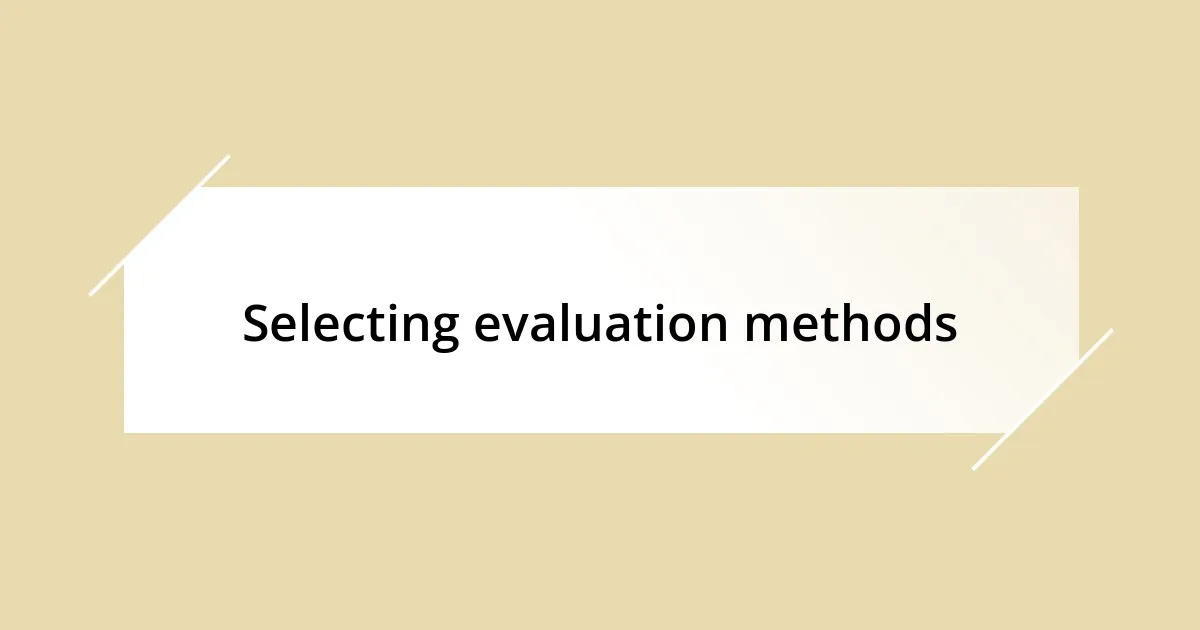
Selecting evaluation methods
When it comes to selecting evaluation methods, I often find myself reflecting on the context and goals of the policy being assessed. For example, in a recent evaluation of an education reform initiative, I carefully considered using both surveys and focus groups. I wanted to capture not just the statistical changes in student performance, but also the nuanced experiences of teachers and students. This dual approach provided a richer understanding of the policy’s impact and highlighted challenges that numbers alone might miss, something I believe is crucial in any evaluation.
Here are some common methods I’ve found effective in my evaluations:
- Surveys: Great for gathering quantitative data from a large group.
- Interviews: Allow for in-depth insights from key stakeholders.
- Focus Groups: Foster discussions, revealing emotional responses and shared experiences.
- Case Studies: Provide rich, qualitative data through specific instances or examples.
- Observations: Offer real-time insights into how a policy is being implemented in practice.
Choosing the right mix of methods really depends on what you’re trying to achieve with your evaluation. I’ve learned that flexibility in this choice can yield the most compelling findings.
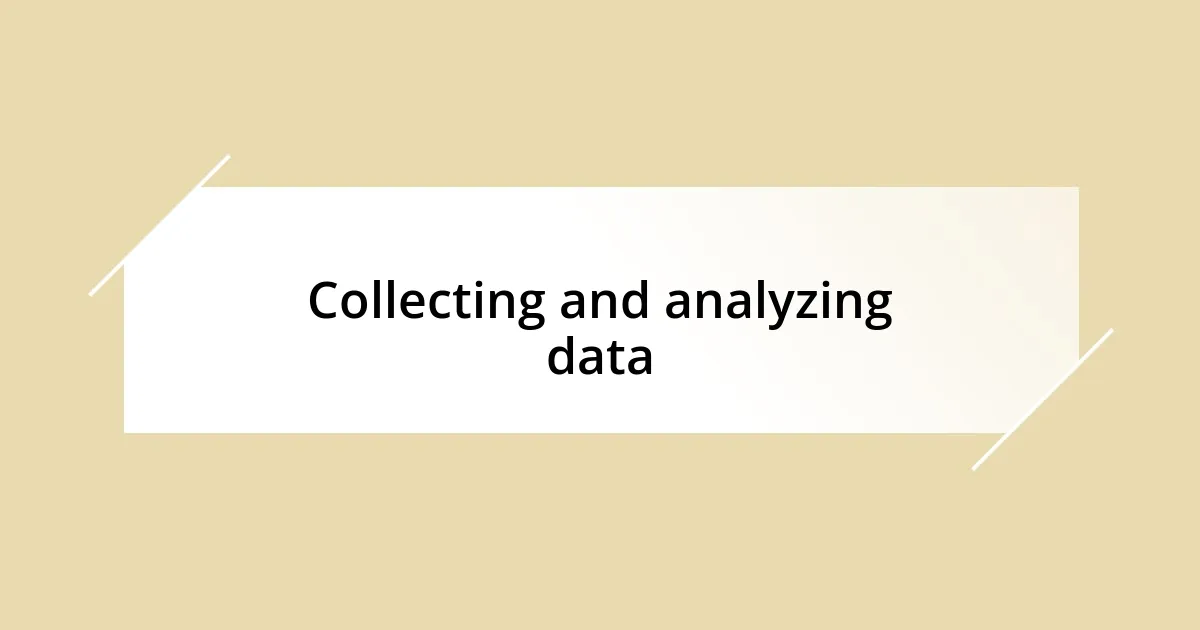
Collecting and analyzing data
Collecting and analyzing data is an essential aspect of any policy evaluation. I often approach this phase with an eye for detail, recognizing that the type and quality of data collected will dramatically shape the results. For instance, I recall conducting a survey for a recent health policy initiative. Some respondents shared their frustrations regarding accessibility, which highlighted gaps that we hadn’t anticipated. This feedback was crucial, revealing a narrative that mere statistics couldn’t convey.
When I analyze the data, I focus not just on the numbers, but on the stories they tell. Have you ever noticed how a single statistic can hold a wealth of insight? During one project, I stumbled upon a particular data point showing a decline in clinic visits. This sparked my curiosity, leading me to investigate further through interviews with staff and patients. What I uncovered was a range of emotional responses tied to perceptions about the policy. It was eye-opening to link the quantitative findings with the qualitative experiences that underpinned them.
I always emphasize the significance of triangulation in my evaluations. By cross-referencing data from multiple sources—like surveys, interviews, and community feedback—I can arrive at a more nuanced understanding of the policy’s impact. It’s not simply about collecting data for the sake of it; it’s about weaving together diverse strands of information to create a more complete tapestry of understanding. Trust me, the richness of insights gained through this method often reveals unexpected lessons that can inform future policy decisions.
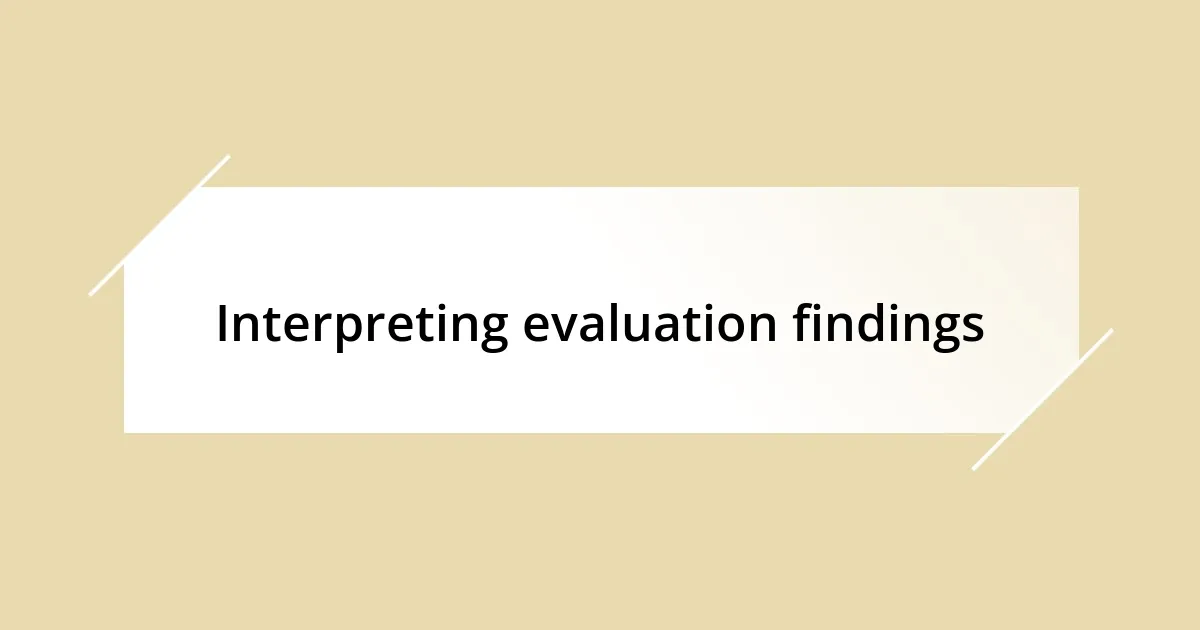
Interpreting evaluation findings
Interpreting evaluation findings is where the real magic happens. In my experience, it’s crucial to look beyond the surface of data. I recall analyzing findings from a housing initiative where the initial numbers suggested success. However, when I dug deeper, I discovered that many beneficiaries didn’t feel safe in their new homes. This discrepancy taught me the importance of context; sometimes numbers can hide deeper narratives. Have you ever had an experience where you thought you understood something, only to realize there was more beneath the surface?
In evaluating data, I often ask myself, “What story is this telling?” This question has guided me through many evaluations. For instance, in a project evaluating a public transportation policy, ridership numbers were up, yet many users expressed dissatisfaction with service reliability. I found it insightful to break down these findings by demographics, revealing that marginalized communities were disproportionately affected. This nuanced interpretation revealed a layer of complexity that pure numbers couldn’t convey alone.
Ultimately, I believe that interpretation is an art as much as it is a science. I like to visualize the data and let it guide my thought process. During an evaluation of a youth engagement program, I created infographics that illustrated trends and highlighted disparities. This visual storytelling not only helped to clarify the findings but also sparked emotional discussions among stakeholders. When we interpret findings with intention and empathy, we can foster a more meaningful dialogue about policies and their impact on real lives.
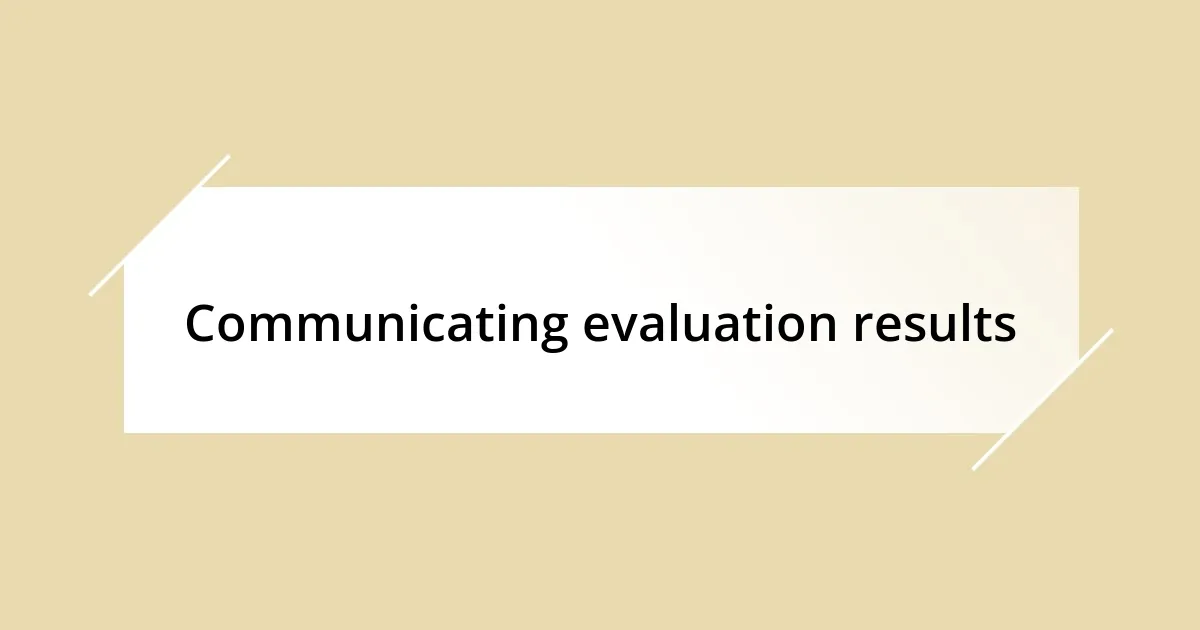
Communicating evaluation results
Communicating evaluation results requires a thoughtful approach to ensure that the insights resonate with all stakeholders. I vividly remember presenting findings from a community health program. As I unveiled the results, I felt the weight of responsibility; what I shared could shape future decisions. Instead of drowning the audience in charts, I narrated the stories behind the data. For instance, highlighting a case where a community member regained mobility and independence after receiving support made the statistics feel alive, turning numbers into relatable experiences.
In my experience, the medium of communication can significantly enhance understanding. I once used a short video clip during a presentation to showcase interviews with beneficiaries. Their candid reflections brought immediate emotion to the room, sparking discussions that a mere report could never ignite. Have you ever noticed how visuals can evoke feelings that words alone sometimes fail to capture? By weaving multimedia elements into the evaluation narrative, I found that audiences were not only engaged but also more likely to take action afterward.
Moreover, I’ve learned that it’s essential to tailor the communication style to the audience’s needs. When I presented to policymakers, I focused on actionable insights and recommendations rather than detailed methodologies. Meanwhile, community members appreciated a more informal approach, filled with relatable anecdotes. Each presentation taught me that adjusting my style can make the difference between a simple information dump and a compelling call to action. After all, effective communication isn’t just about delivering results; it’s about inspiring change.
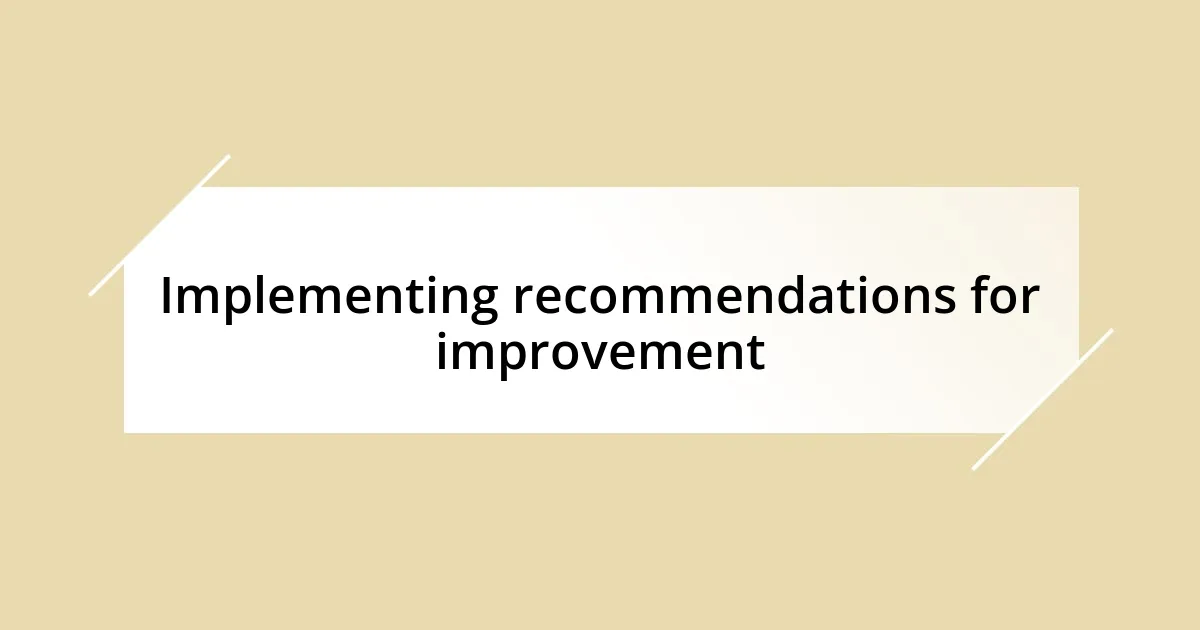
Implementing recommendations for improvement
Implementing recommendations for improvement often feels like tackling a puzzle, where each piece must fit perfectly to see the bigger picture. I recall leading a neighborhood revitalization project where we identified key areas for improvement—like enhancing public spaces and increasing community engagement. The challenge lay in prioritizing these recommendations; my team had to ensure that every step we took resonated with the community’s needs. Have you ever been in a situation where your plans seemed solid, only to find the details unraveling? That taught me the importance of staying adaptable and open to community feedback.
One memorable experience involved a youth mentorship initiative where we recommended introducing more structured programming based on our evaluations. During our pilot phase, I organized focus groups and invited feedback from participants. Their insights were eye-opening; they expressed a need for more hands-on activities rather than an emphasis on academic tutoring. This shift taught me that implementing change isn’t just about following the plan but also about actively listening and being responsive to those impacted. How often do we overlook the voices of those we aim to help?
Moreover, I’ve come to appreciate the significance of follow-through after recommendations are set in motion. After implementing changes to a neighborhood’s green spaces, I facilitated regular community check-ins, allowing residents to voice their thoughts on the alterations. I found this continual engagement fostered a sense of ownership among community members, significantly enhancing the project’s success. Sometimes it’s not just about making the changes; it’s about nurturing a sustained relationship that drives improvement forward. Have you ever seen how a small act of involvement can ignite a greater sense of community? These moments reaffirm my belief in the power of collaboration and ongoing communication as essential elements for lasting improvement.



